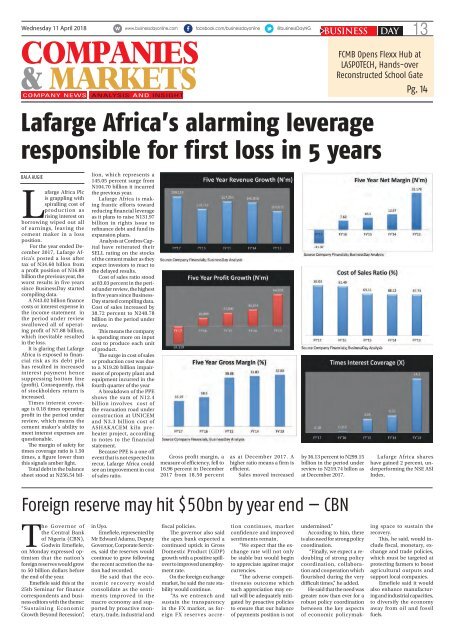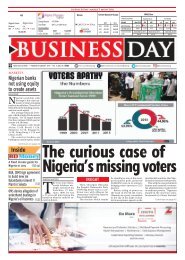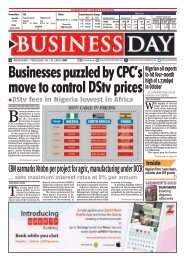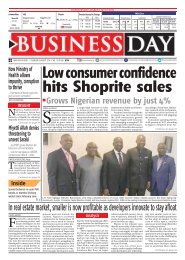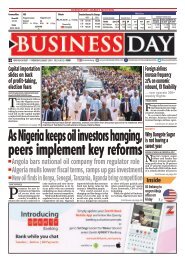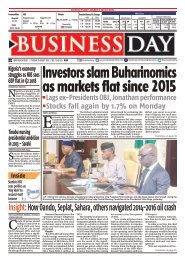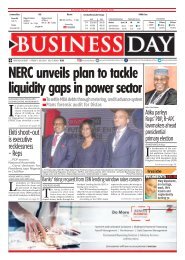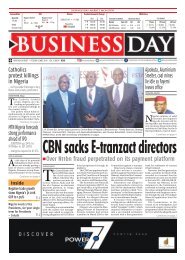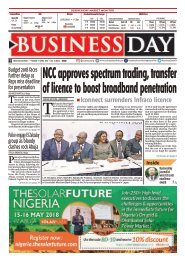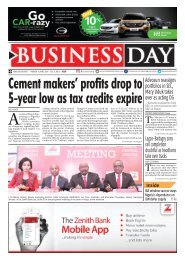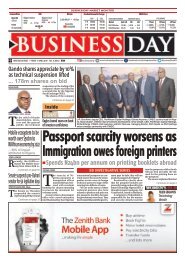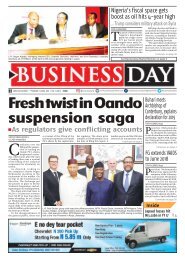BusinessDay 11 Apr 2018
Create successful ePaper yourself
Turn your PDF publications into a flip-book with our unique Google optimized e-Paper software.
Wednesday <strong>11</strong> <strong>Apr</strong>il <strong>2018</strong><br />
COMPANIES<br />
& MARKETS<br />
Company news analysis and insight<br />
BUSINESS DAY 13<br />
FCMB Opens Flexx Hub at<br />
LASPOTECH, Hands-over<br />
Reconstructed School Gate<br />
Pg. 14<br />
Lafarge Africa’s alarming leverage<br />
responsible for first loss in 5 years<br />
BALA AUGIE<br />
lion, which represents a<br />
145.05 percent surge from<br />
N104.70 billion it incurred<br />
the previous year.<br />
Lafarge Africa is making<br />
frantic efforts toward<br />
reducing financial leverage<br />
as it plans to raise N131.97<br />
billion in rights issue to<br />
refinance debt and fund its<br />
expansion plans.<br />
Analysts at Cordros Capital<br />
have reiterated their<br />
SELL rating on the stocks<br />
of the cement maker as they<br />
expect investors to react to<br />
the delayed results.<br />
Cost of sales ratio stood<br />
at 83.03 percent in the period<br />
under review, the highest<br />
in five years since Business-<br />
Day started compiling data.<br />
Cost of sales increased by<br />
38.72 percent to N248.78<br />
billion in the period under<br />
review.<br />
This means the company<br />
is spending more on input<br />
cost to produce each unit<br />
of product.<br />
The surge in cost of sales<br />
or production cost was due<br />
to a N19.20 billion impairment<br />
of property plant and<br />
equipment incurred in the<br />
fourth quarter of the year<br />
A breakdown of the PPE<br />
shows the sum of N12.4<br />
billion involves cost of<br />
the evacuation road under<br />
construction at UNICEM<br />
and N3.3 billion cost of<br />
ASHAKACEM kiln preheater<br />
project, according<br />
to notes to the financial<br />
statement.<br />
Because PPE is a one off<br />
event that is not expected to<br />
recur, Lafarge Africa could<br />
see an improvement in cost<br />
of sales ratio.<br />
Gross profit margin, a<br />
measure of efficiency, fell to<br />
16.96 percent in December<br />
2017 from 18.50 percent<br />
Lafarge Africa Plc<br />
is grappling with<br />
spiralling cost of<br />
production as<br />
rising interest on<br />
borrowing wiped out all<br />
of earnings, leaving the<br />
cement maker in a loss<br />
position.<br />
For the year ended December<br />
2017, Lafarge Africa’s<br />
posted a loss after<br />
tax of N34.60 billon from<br />
a profit position of N16.89<br />
billion the previous year, the<br />
worst results in five years<br />
since <strong>BusinessDay</strong> started<br />
compiling data.<br />
A N43.02 billion finance<br />
costs or interest expense in<br />
the income statement in<br />
the period under review<br />
swallowed all of operating<br />
profit of N7.88 billion,<br />
which inevitable resulted<br />
in the loss.<br />
It is glaring that Lafarge<br />
Africa is exposed to financial<br />
risk as its debt pile<br />
has resulted in increased<br />
interest payment hence<br />
suppressing bottom line<br />
(profit). Consequently, risk<br />
of stockholders return is<br />
increased.<br />
Times interest coverage<br />
is 0.18 times operating<br />
profit in the period under<br />
review, which means the<br />
cement maker’s ability to<br />
meet interest expenses are<br />
questionable.<br />
The margin of safety for<br />
times coverage ratio is 1.50<br />
times, a figure lower than<br />
this signals amber light.<br />
Total debt in the balance<br />
sheet stood at N256.54 bilas<br />
at December 2017. A<br />
higher ratio means a firm is<br />
efficient.<br />
Sales moved increased<br />
by 36.13 percent to N299.15<br />
billion in the period under<br />
review to N219.74 billon as<br />
at December 2017.<br />
Lafarge Africa shares<br />
have gained 2 percent, underperforming<br />
the NSE ASI<br />
Index.<br />
Foreign reserve may hit $50bn by year end — CBN<br />
The Governor of<br />
the Central Bank<br />
of Nigeria (CBN),<br />
Godwin Emefiele,<br />
on Monday expressed optimism<br />
that the nation’s<br />
foreign reserves would grow<br />
to 50 billion dollars before<br />
the end of the year.<br />
Emefiele said this at the<br />
25th Seminar for finance<br />
correspondents and business<br />
editors with the theme:<br />
“Sustaining Economic<br />
Growth Beyond Recession”,<br />
in Uyo.<br />
Emefiele, represented by<br />
Mr Edward Adamu, Deputy<br />
Governor, Corporate Services,<br />
said the reserves would<br />
continue to grow following<br />
the recent accretion the nation<br />
had recorded.<br />
He said that the economic<br />
recovery would<br />
consolidate as the sentiments<br />
improved in the<br />
macro economy and supported<br />
by proactive monetary,<br />
trade, industrial and<br />
fiscal policies.<br />
The governor also said<br />
the apex bank expected a<br />
continued uptick in Gross<br />
Domestic Product (GDP)<br />
growth with a positive spillover<br />
to improved unemployment<br />
rate.<br />
On the foreign exchange<br />
market, he said the rate stability<br />
would continue.<br />
“As we entrench and<br />
sustain the transparency<br />
in the FX market, as foreign<br />
FX reserves accretion<br />
continues, market<br />
confidence and improved<br />
sentiments remain.<br />
“We expect that the exchange<br />
rate will not only<br />
be stable but would begin<br />
to appreciate against major<br />
currencies.<br />
“The adverse competitiveness<br />
outcome which<br />
such appreciation may entail<br />
will be adequately mitigated<br />
by proactive policies<br />
to ensure that our balance<br />
of payments position is not<br />
undermined.”<br />
According to him, there<br />
is also need for strong policy<br />
coordination.<br />
“Finally, we expect a redoubling<br />
of strong policy<br />
coordination, collaboration<br />
and cooperation which<br />
flourished during the very<br />
difficult times,” he added.<br />
He said that the need was<br />
greater now than ever for a<br />
robust policy coordination<br />
between the key aspects<br />
of economic policymak-<br />
ing space to sustain the<br />
recovery.<br />
This, he said, would include<br />
fiscal, monetary, exchange<br />
and trade policies,<br />
which must be targeted at<br />
protecting farmers to boost<br />
agricultural outputs and<br />
support local companies.<br />
Emefiele said it would<br />
also enhance manufacturing<br />
and industrial capacities,<br />
to diversify the economy<br />
away from oil and fossil<br />
fuels.


